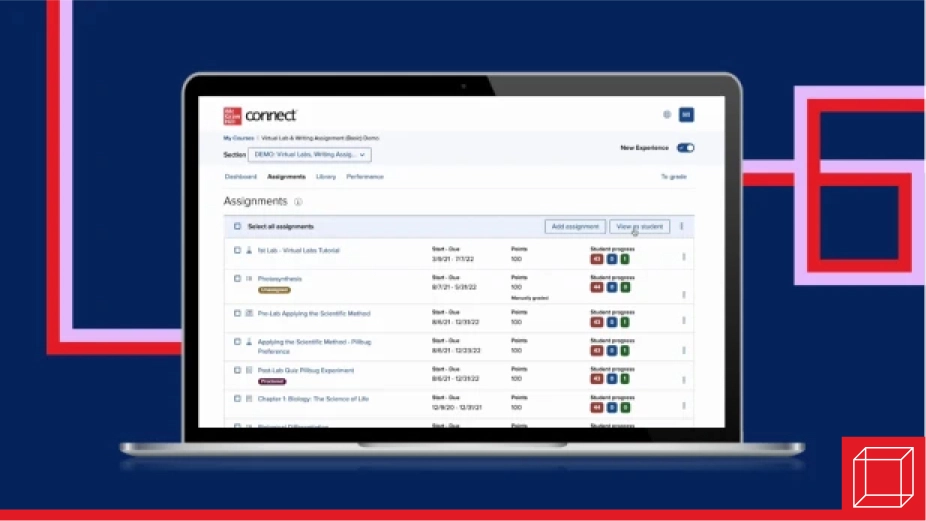Assessment Strategies for Better Learning Outcomes with McGraw Hill Connect®
Assessments within Connect can be powerful tools for enhancing student understanding, critical thinking, and retention of course material.

Assessments within Connect can be powerful tools for enhancing student understanding, critical thinking, and retention of course material. As educators, we know all students have different learning styles; they can be auditory, kinesthetic, or visual learners. Engaging students is key to both their—and our—success.
Below are several strategies you can employ to design and utilize assessments effectively in your course:
1. Align Learning Objectives: Ensure all assessments are aligned with clear learning objectives for the course. This helps students understand the purpose of assessments and how they relate to their overall learning goals. Connect provides several tools to assist with aligning course outcomes and even certification outcomes for various fields and careers.
2. Vary Assessment Types: Use various assessment types, such as quizzes, tests, essays, discussions, and projects. Different assessment formats cater to the array of learning styles and can engage a broader range of students.
3. Use Formative and Summative Assessments: Incorporate both formative (ongoing, low-stakes) and summative (high-stakes, end-of-unit) assessments. Formative assessments can help students practice and receive feedback, while summative assessments evaluate their overall understanding.
4. Give Timely Feedback: Provide prompt and constructive feedback on assessments. Use the feedback to guide students on areas of improvement and reinforce correct concepts. Connect’s automated grading and performance tracking can help with this.
5. Offer Open-Book and Open-Note Assessments: Occasionally, use open-book or open-note assessments to encourage critical thinking rather than rote memorization. This can prompt students to apply their knowledge to solve complex problems. Most Connect courses incorporate an eBook that makes this easy to implement.
6. Design Progressive Assessments: Make assessments that build on each other, progressively increasing complexity. This helps students scaffold their learning and ensures they have a solid foundation before tackling more advanced concepts.
7. Use Technology for Interactivity: Utilize Connect's interactive features and a variety of assignment types. These tools can make assignments and assessments more engaging and relevant to students.
8. Apply to the Real World: Incorporate real-world scenarios and case studies into assessments. This helps students see the practical relevance of the course material and encourages critical thinking in problem-solving.
9. Encourage Self-Assessment and Reflection: Inspire students to self-assess and reflect on their learning progress using Connect. This can be done through journals, learning portfolios, self-assessment quizzes, and open or private conversations. Connect also gives students reports that allow them to track their own learning by revealing where they’re struggling.
10. Explore Adaptive Learning: If Connect offers adaptive learning features, such as the Adaptive Learning Assignments or SmartBookÒ, leverage them to personalize assessments for each student's needs. Adaptive assessments can adjust the difficulty based on individual performance. Students also know exactly where they need to study with SmartBook’s Recharge.
11. Use Analytics and Data Insights: Track student performance and knowledge with Connect's analytics tools. Instructor reports allow you to easily see class and individual student-level assignment data, so you can target intervention and additional support.
12. Offer Revision Opportunities: Provide students the chance to revise and resubmit assessments after receiving feedback. This promotes a deeper understanding and mastery of the material. Connect makes it easy to set up assignments for multiple attempts.
13. Wrap Exams: After major Connect assessments, use exam wrappers where students reflect on their performance, study strategies, and areas for improvement. This metacognitive approach can enhance retention and critical thinking skills.
14. Provide Rubrics and Clear Grading Criteria: Ensure students are familiar with rubrics and clear assessment grading criteria. This transparency helps students understand expectations and how they will be assessed.
15. Incorporate Gamification: If appropriate, gamify assessments to make learning more engaging and fun. Gamification elements like leaderboards, badges, and rewards can motivate students to think critically and retain information.
These strategies have worked for me to build student engagement and success. I hope by implementing these strategies within Connect, you can also create a more engaging and effective learning experience. Students will increase their understanding, critical thinking, and retention of course material. Additionally, regularly assessing and adjusting assessment methods based on student feedback can help improve your learning outcomes.
